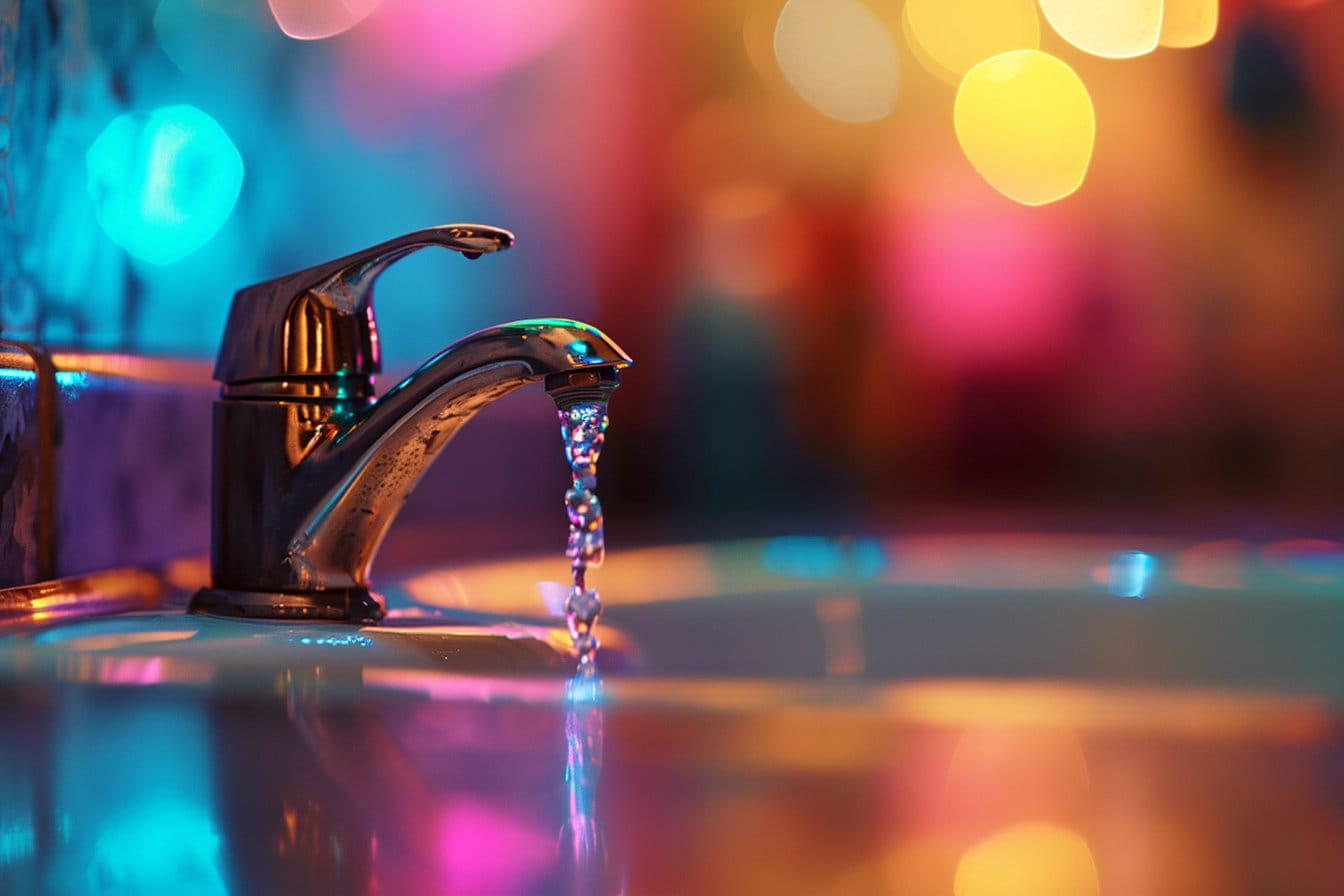Stepping into the world of home maintenance as a single mom can feel overwhelming, especially when plumbing problems arise.
But fear not! Many of these common issues are surprisingly manageable, and don’t always require a professional plumber.
Learning how to manage basic plumbing fixes can be both a time and money saver. Here, get some easy fixes for common plumbing woes like dripping faucets, running toilets, and clogged drains — helping you empower yourself to tackle these challenges with confidence.
1. How to fix a dripping faucet
- Identify the faucet type: Determine whether your faucet is a compression faucet (which has two handles) or a washerless faucet (such as a ball, disc, or cartridge type). Get more details about these differences below.
- Shut off the water: Turn off the water supply to the faucet. You’ll usually find the valve/s under the sink.
- Disassemble the faucet: Carefully remove the handle and other parts. Keep track of the order and orientation of these parts (snap photos if a visual record might help you), and keep them together.
- Inspect for damage: Look for worn-out washers or O-rings and replace them. These are often the cause of dripping. They’re usually very inexpensive to replace, and are easy to find — like in this kit from Amazon.
Identifying the type of faucet you have is crucial when fixing a dripping faucet because the type determines the internal mechanism at work, and hence, the method of repair. Different types of faucets are constructed differently and have specific parts that may wear out or malfunction.

Compression faucet: This is a traditional type of faucet with two handles, one for hot and one for cold water. A compression faucet operates with washers that compress against a valve seat. A dripping issue in these faucets is often due to worn-out washers or a damaged valve seat.
Washerless faucets: These include ball, disc, and cartridge types and do not use washers. Instead, they have a single handle and function through the movement of a cartridge, disc, or ball against a seal. Dripping in these faucets typically results from worn O-rings, corroded valve seats, or mineral deposits.
- Ball faucets: They have a single handle attached to a rounded cap. The dripping is usually due to worn O-rings or ball assembly issues.
- Disc faucets: Characterized by a single lever over a wide cylindrical body, the issue often lies within the ceramic discs.
- Cartridge faucets: These can have one or two handles. Dripping generally indicates that you need to replace the cartridge or O-rings.
Knowing the type helps you understand what parts to inspect, repair, or replace. For example, if you have a compression faucet, you’ll likely be looking for a worn washer, whereas with a cartridge faucet, you might need to replace the cartridge or the O-rings. This knowledge ensures that you address the correct part of the faucet, making your repair more effective and preventing further damage.
2. How to fix common kitchen faucet leaks
When a faucet is dripping at the end where the water comes out, often the issue is related to the aerator or the internal parts of the faucet. The aerator is the screen-like component at the end of the faucet where water is dispensed. Over time, it can become clogged with mineral deposits or debris from the water, leading to dripping or an uneven water flow. Here are steps to address this issue:
Clean or replace the aerator:
- Remove the aerator: Typically, you can unscrew the aerator by hand. If it’s tight, use a pair of pliers with a cloth to protect the finish.
- Inspect and clean: Once removed, check for any sediment or debris. Clean the aerator by rinsing it under water. You can also soak it in vinegar to dissolve mineral deposits.
- Replace if necessary: If the aerator is damaged or excessively clogged, replacing it might be the best option. Aerators are generally inexpensive and easy to find at hardware stores.
Check for internal faucet issues: If cleaning the aerator doesn’t resolve the dripping, the problem might be within the faucet itself. This could be due to worn-out internal components like washers, seals, or a cartridge, depending on your faucet type.
Consider water pressure issues: Sometimes, high water pressure can cause dripping at the faucet’s end. If you suspect this, a plumber can help you check and adjust the pressure.
Seek professional help if needed: If you’re unsure, or if the problem persists after trying these steps, it may be wise to consult a plumber. They can diagnose and fix more complex issues that might not be apparent at first glance.
3. How to fix a toilet that won’t stop running
- Check the flapper: Remove the toilet tank lid. If the flapper (the rubber piece at the bottom of the tank) isn’t sealing properly, adjust or replace it.
- Adjust the float: The float controls the water level. If it’s set too high, water can flow into the overflow tube. Adjust it to lower the water level.
- Inspect the fill tube: Ensure the fill tube (small tube attached to the fill valve) is intact and positioned correctly, slightly above the water level.
4. How to clear clogged drains
- Use a plunger: For minor clogs, a plunger can often do the trick. Use it to create suction and dislodge the blockage.
- Baking soda and vinegar: Pour half a cup of baking soda down the drain, followed by half a cup of vinegar. Cover the drain and let it sit for an hour, then flush with hot water.
- Manual cleaning: Remove the drain cover and use a straightened wire hanger, drain snake or plastic hair removal tool to pull out debris.
5. How to fix a stuck garbage disposal
If your garbage disposal has stopped working, one of the first things to try is using a garbage disposal wrench/key tool — which is really a version of a hex or Allen wrench. This tool is often included with your disposal, or you can purchase one from a hardware store or at Amazon. Here’s how to use it:
Safety first: Before doing anything, make sure the garbage disposal is turned off. For extra safety, unplug it or turn off the circuit breaker that powers it.
Locate the hole for the wrench/key: On the bottom side of your garbage disposal unit, you’ll find (or feel) a small hole in the center. This is where you’ll insert the key.
ALSO SEE: Can you put eggshells down the garbage disposal?
Insert the key: Fit the garbage disposal key or a 1/4-inch Allen wrench into the hole. Once it’s in, you’ll use it to manually turn the disposal’s motor.
Turn the key: Gently rotate the key back and forth. This movement helps to dislodge any materials that may be jamming the blades. If you feel resistance, that’s likely the obstruction. Continue to move the key back and forth until it turns freely in a full circle, which indicates that the jam has been cleared.
Remove the key and test: Once the key turns freely, remove it, turn the power back on, and press the reset button on the disposal (usually located at the bottom of the unit). Finally, run water and then turn on the disposal to test if it’s working correctly.
Using the garbage disposal key tool is a simple and effective first step in troubleshooting a stopped disposal. It can often resolve the issue without the need for professional help, saving both time and money.
- Garbage Disposal Wrench: Helps you quickly and effectively remove blockages in your garbage disposal and unclog food debris such as jam in your kitchen sink, and solve humming noises. Compatible with...
- Easy to Install: Just insert the wrench into the hex socket hole in the center of the bottom of the garbage disposal, turn the wrench back and forth until it can turn freely in both directions, and...
- Durable and Compact: Strong and durable alloy steel, it will be a little harder than ordinary alloy steel, so you don't have to worry about breaking easily when using it. Flexible corner design, easy...
Don’t forget basic preventative plumbing maintenance
- Regularly clean drains: Prevent clogs by regularly cleaning drains and avoiding disposing of grease, eggshells, coffee grounds, and non-flushable items down them.
- Inspect for leaks: Regularly check under sinks and around toilets for signs of leaks. Early detection can prevent larger problems.
- Know Your main water valve: Knowing the location of your home’s main water shut-off valve is crucial in case of a major leak or plumbing emergency.
Empower yourself with basic plumbing skills
Basic plumbing maintenance is a valuable skill for any homeowner. By learning to handle common issues like dripping faucets, running toilets, and clogged drains, you can maintain your home’s plumbing system and prevent minor problems from becoming major ones.
Of course, if a problem seems too complex or you’re concerned you might not be able to handle it, it’s always wise to consult a professional plumber.
Where do you find a good plumber?
A great starting point for finding an affordable and reliable plumber is to ask your friends, family, or neighbors for recommendations, as personal experiences often lead to trustworthy suggestions.
As a next step, you can also check local community groups or forums online, such as neighborhood Facebook groups or platforms like Nextdoor, where residents often share their experiences and recommend local services.
Additionally, you can consult professional associations or websites that provide ratings and reviews, such as the Better Business Bureau, Thumbtack, Yelp, Angi.com (formerly Angie’s List), or HomeAdvisor.
- Hardcover Book
- Editors of Creative Homeowner (Author)
- English (Publication Language)
- Editors of Creative Homeowner (Author)
- English (Publication Language)
- 312 Pages - 05/25/2021 (Publication Date) - Creative Homeowner (Publisher)
- Great product!
- Cauldwell, Rex (Author)
- English (Publication Language)
- Beautiful Hardcover edition
- Sharp detailed images
- Easy to read and understand





















